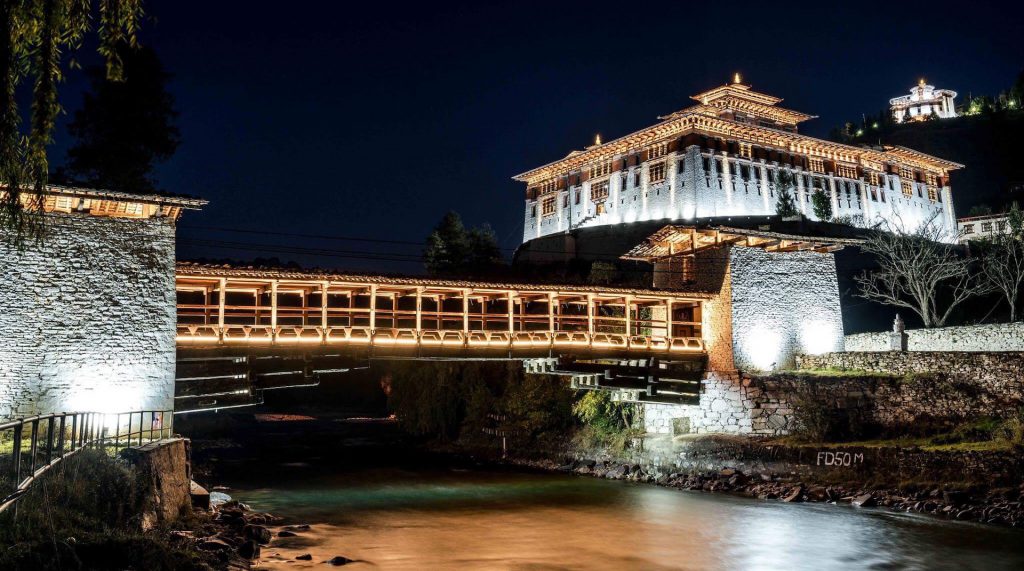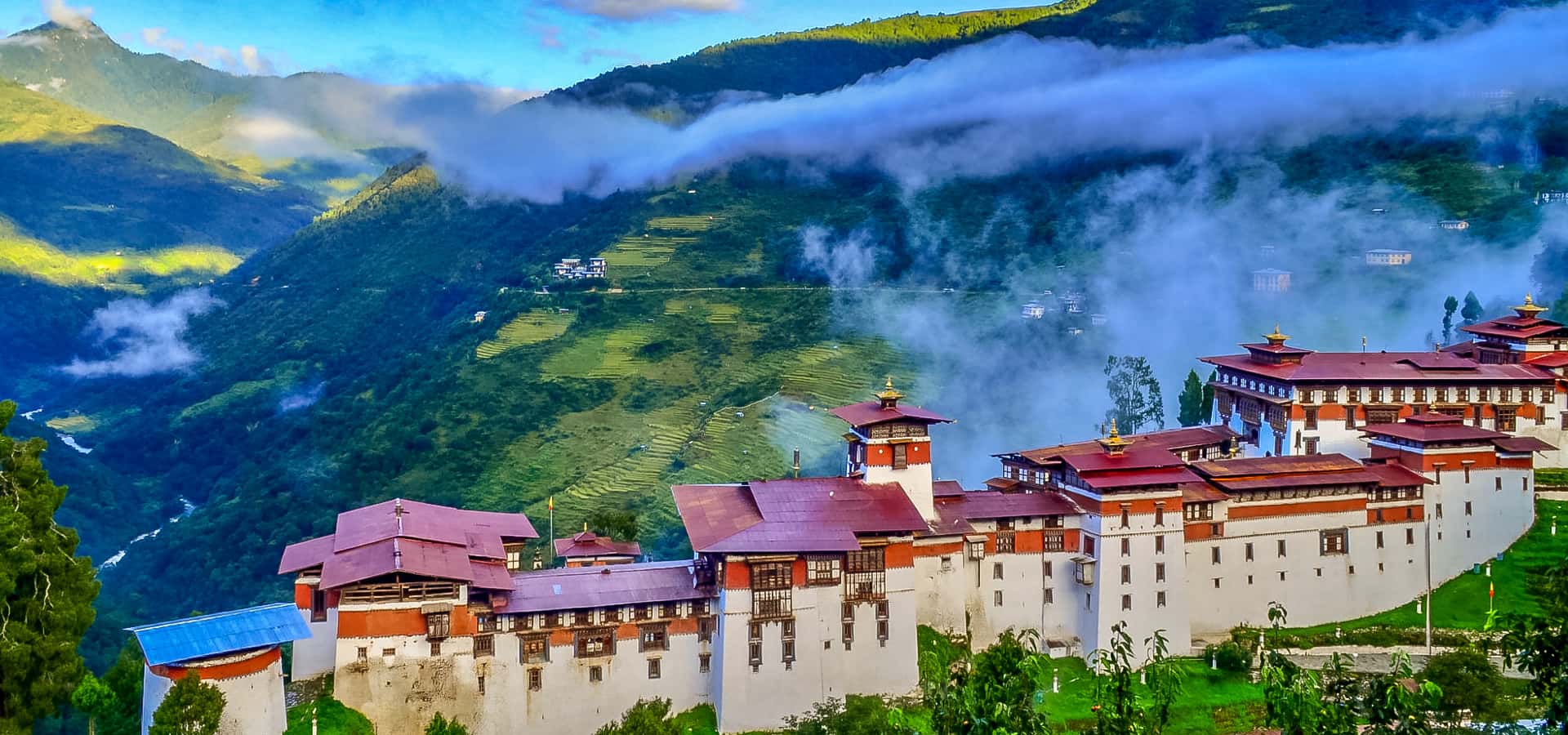- Day 01: Arrive Paro by Druk Air & transfer to Thimphu
- Day 02: Thimphu – Paro
- Day 03: Paro
- Day 04: Depart Paro
Day 01: Arrive Paro by Druk Air & transfer to Thimphu
The flight to Paro is one of the most spectacular in entire Himalayas. Flying along the Himalayan
range from Kathmandu, the journey offers fascinating views and an exciting descent into the
Kingdom. Bhutan’s first gift to you as you disembark from the aircraft will be cool, clean fresh
mountain air. After immigration formalities and baggage collection, you will be met by our
representative, and afterwards drive to Thimphu, the capital town of Bhutan.
On arrival, in Thimphu- The capital town of Bhutan and the centre of government, religion and
commerce, Thimphu is a unique city with unusual mixture of modern development alongside
ancient traditions. With the population of about 90,000 it is perhaps still the world’s only capital city
without a traffic light.
Visit following places:
Tachogang Lhakhang is located in Paro district, on the way to Thimphu. It was founded by
Thankthong Gyelpo after he experienced a vision of Guru Rimpochhe, Amitaba and
Avalokiteshvara near site. The caretakers today are said to be descendants of Thangtong Gyelpo.
Inside the temple one can see the masters relics, including his walking stick come here to get
auspicious names for their newborns or blessings for their young children from the protector deity
Tamdrin (to the left in the grilled inner sanctum). Children are blessed by a phurba (ritual dagger)
and given a sacred thread.
.
Conclude the tour of the day with a visit of Trashichhoedzong, “fortress of the glorious religion”.
This is the center of government and religion, site of monarch’s throne room and seat of Je
Khenpo or Chief Abbot. Built in 1641 by the political and religious unifier of Bhutan, Shabdrung
Ngawang Namgyel, it was reconstructed in 1960s in traditional Bhutanese manner, without nails or
architectural plans.
Optional:
If you would like to view or buy Bhutanese handicrafts you may like to visit the new market
opposite Taj Tashi Hotel which has an array of stalls run by local handicraft shops selling purely
homemade articles with no imports. Or visit Kaja Throm.
(Overnight at the hotel in Thimphu). (Altitude 2,320 m)
Day 02: Thimphu – Paro
After breakfast, proceed for the guided tour of city’s main attractions that includes:
Buddha Point (Kuensel Phodrang). Located at a short drive from Thimphu city centre, visitors
can get a good overview of the Thimphu valley from the Buddha point (KuenselPhodrang). You
can pay your obeisance and offer prayers to the Buddha, the largest statue in the country and then
walk around and take a glimpse of the valley.
Memorial Chorten: The stupa built in the memory of Bhutan's third King, His Late Majesty, King
Jigme Dorji Wangchuk, who is popularly regarded as Father of modern Bhutan. The paintings and
statues inside the monument provide a deep insight into Buddhist philosophy.
Later drive to Dochula pass (3100m) which offers majestic view of eastern Himalayas and drive back
enroute visit Simtokha Dzong known as Sangak Zabdhon Phodrang (Palace of the Profound Meaning of
Secret Mantras), Simtokha is often said to be the first dzong built in Bhutan. In fact, there were dzongs in
Bhutan as early as 1153, but this was the first dzong built by the Zhabdrung, and was the first structure to
incorporate both monastic and administrative facilities. It is also the oldest dzong to have survived as a
complete structure.
After lunch visit drive to Paro.
Visit Nation Museum
Rimpung Dzong is probably Bhutan's best known and most iconic Dzhong. This is probably the first building
you will notice when you land at Paro International Airportand will probably be your first memory of Bhutan.
The imposing Dzhong is perhaps the finest example of Dzhong architecture existing the world today, the
massive buttered walls of the fortress dominate over the valley. The Rinpung Dzhong's names translates to
the " Fortress on a heap of Jewels "
(Overnight at the hotel in Paro)
Day 03: Paro
After breakfast drive to Paro and do hike to Taktshang Monastery (5hrs hike): It is one of the most
famous of Bhutan’s monasteries, perched on the side of a cliff 900m above the Paro valley floor. It
is said that Guru Rinpoche arrived here on the back of a tigress and meditated at this monastery
and hence it is called ‘Tiger’s Nest’. This site has been recognized as a most sacred place and
visited by Shabdrung Ngawang Namgyel in 1646 and now visited by all Bhutanese at least once in
their lifetime. On 19 April 1998, a fire severely damaged the main structure of building but now this
Bhutanese jewel has been restored to its original splendor.
Along the way, visit the 7th century KyichuLhakhang, one of the 108 temples built in the
Himalayas by Tibetan King, Songtsen Gampo. The building of this temple marks the
introduction of Buddhism in Bhutan.
In evening we will visit local market of Paro.
(Overnight in a hotel in Paro) ( Altitude: 2200m)
Optional:
Try Hot stone bath (Traditional hot stone bath)
Try Horse Riding Adventure
Try Archery (National Sport) and Bhutanese cuisine at One of the old Farmhouse
Day 04: Depart Paro
After early breakfast at the hotel, drive to the airport for flight to your onward destination.
Our representative will help you with exit formalities and then bid you farewell.
******END OF SERVICE******

1. Do I need a visa to visit Bhutan?
Yes, travelers to Bhutan need a visa. The process is handled through a licensed Bhutanese tour operator, and you must book your trip through them. The operator will submit your visa application to the Bhutanese Department of Immigration. Once approved, you'll receive a visa clearance letter, which you must present upon arrival in Bhutan.
2. What is the best time to visit Bhutan?
he best times to visit Bhutan are during the spring (March to May) and fall (September to November) when the weather is pleasant, and the skies are clear. These seasons offer ideal conditions for sightseeing, trekking, and cultural events. The winter months (December to February) can be quite cold, especially in the high-altitude regions, while the summer months (June to August) are the monsoon season, which might bring heavy rains.
3. What is the daily minimum spending requirement for tourists in Bhutan?
Bhutan operates on a "minimum daily package" system for tourists from most countries. The daily minimum spending requirement typically includes accommodation, meals, transportation within Bhutan, and a guide
4. Is it safe to travel to Bhutan?
Yes, Bhutan is generally considered a very safe destination for travelers. The country has low crime rates, and the locals are known for their hospitality. However, like any destination, it’s wise to stay vigilant and follow local advice, particularly in remote areas.
We have different packages for this trip feel free to contact us for more.
Cost Inclusion
Daily Goverment Royalties and Taxes ($100 per person per night)
Enterance fees / Monuments Fee
All Transfe vehicles and sightseeing as per the iteneary
English-speaking accomanying guide
Accommodation as per below - starts mentioned hotels
Breakfast and dinner at the hotel and lunch at the local tourist restaurant
1 Bottle of water per day during trek
Cost Exclusion
Bhutan Visa fee is US$40
Beverage
Expenses of personal nature like tipping,laundry,telephone, fax calls, camera,video fees etc
Insurance of any kind / medical expenses
Air tickets



